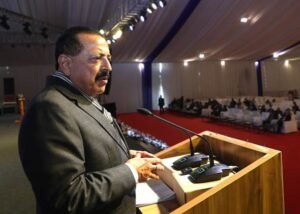Hockey India League: India’s dribblers all set to hit turf
Arijit Bose October 12, 2024
New Delhi: The Hockey India League (HIL), which first came into existence in 2013, has played a transformative role in shaping Indian hockey, bringing it back to the forefront of the nation’s sporting consciousness.
While the league has gone through periods of tremendous growth and occasional setbacks, its contribution to the sport in India is undeniable. Over the years, it has evolved in terms of competition, talent development, financial support, and its global reach. Here’s a deep dive into the evolution of the Hockey India League over the last decade.
Inception and Early Years (2013-2017)
The Hockey India League was launched in 2013, modeled after the success of India’s Indian Premier League (IPL) in cricket. Hockey, which had been India’s most dominant sport through the first half of the 20th century, had lost its national appeal, overshadowed by cricket’s immense popularity. The HIL aimed to revive the sport’s fortunes by creating a professional platform for domestic and international talent to showcase their skills.
Key Numbers and Stats:
- 2013 Debut Season: The inaugural HIL season saw five teams—Delhi Waveriders, Jaypee Punjab Warriors, Ranchi Rhinos, Uttar Pradesh Wizards, and Mumbai Magicians—competing. The league featured 34 matches, and Ranchi Rhinos emerged as the first-ever champions, defeating Delhi Waveriders 2-1 in the final.
- Viewership: The league garnered impressive viewership, with over 41 million people watching the tournament in its first year, indicating a strong start.
Expansion and Rise (2014-2017)
After the success of the first season, the Hockey India League began to grow. The league expanded by adding more teams, improved its broadcasting rights, and attracted sponsorship from major corporations. With high-caliber international players joining the league, the competition’s level intensified, helping Indian players to hone their skills.
Key Developments:
- Star International Players: The HIL attracted international stars like Jamie Dwyer (Australia), Moritz Fürste (Germany), and Sardar Singh (India), among others. These players brought invaluable experience, raising the quality of the league.
- 2014-2017 Teams: The franchise-based model included teams like Kalinga Lancers and Dabang Mumbai, who joined later, expanding the roster of competing sides.
- Salary Growth: As the league grew in stature, player salaries increased. In 2017, Germany’s Moritz Fürste was the highest-paid player in HIL, fetching an incredible USD 105,000 in the player auction. Indian stars like PR Sreejesh also commanded high salaries, earning USD 69,000 in the same year.
Rising Popularity:
- Viewership Surge: By 2017, the viewership had doubled, crossing the 82 million mark, largely due to improved broadcasting deals and the inclusion of top-tier international talent.
- Social Media Engagement: HIL’s presence on social media platforms like Facebook, Instagram, and Twitter grew exponentially. The league tapped into younger audiences through digital marketing, which helped expand hockey’s appeal beyond traditional fan bases.
Impact on Indian Hockey
The impact of HIL on Indian hockey cannot be overstated. The league played a vital role in strengthening the national team by providing players with high-intensity match experience and helping the national selectors identify emerging talent.

Key Effects:
- Talent Development: Many Indian players who gained prominence in the HIL went on to become key players for the national team. Rupinder Pal Singh, Manpreet Singh, and Mandeep Singh are prime examples of players who thrived in HIL and became mainstays in the national team.
- India’s Hockey Resurgence: From 2016 onwards, India’s men’s national team showed significant improvement in international tournaments. India’s gold at the 2016 Asian Champions Trophy and a strong showing in the 2018 World Cup can partly be attributed to the experience players gained in the HIL.
Challenges and Hiatus (2018-2023)
Despite its success, the Hockey India League faced challenges that forced it into a hiatus after the 2017 season. Financial strains, franchise issues, and a crowded international hockey calendar made it difficult for HIL to continue in its original form.
Key Challenges:
- Sponsorship and Funding Issues: Despite initial success, some franchises faced financial difficulties. The high cost of maintaining a team, coupled with the growing player salaries, made it difficult for some franchise owners to sustain their participation.
- Scheduling Conflicts: The International Hockey Federation’s (FIH) expanding global hockey calendar created a conflict in scheduling, with many top international players unable to participate in the HIL.
- Hiatus Announcement: In 2018, Hockey India announced that the league would be temporarily halted. This came as a blow to Indian hockey, which had come to rely on HIL for player development and public engagement.
The Return of HIL (2024 and Beyond)
After a long hiatus, the announcement of HIL’s return in 2024 has sparked excitement across the hockey world. The revival comes at a time when India’s hockey teams (both men and women) are riding high on the success of the Tokyo 2020 Olympics, where the men’s team won a bronze medal after 41 years.
What to Expect in 2024:
- Revamped League Format: The 2024 edition is expected to feature a new, streamlined format. The league will likely focus on reducing team costs while maintaining a competitive and high-quality product.
- Sponsorship Surge: With the renewed interest in Indian hockey following the Tokyo Olympics success, corporate sponsors are likely to return in greater numbers. Brands like Hero MotoCorp and Sahara, which have been long-time sponsors, may also renew their association.
- Team Expansion: The 2024 edition might see new teams from hockey-proud states like Odisha and Punjab, further expanding the league’s reach.
- Player Salaries: With a more streamlined format and controlled financial outlay, player salaries might not reach previous peaks but will still provide strong financial incentives for Indian players.
By the Numbers: Evolution and Impact
- 2013 Inaugural Season: 5 teams, 34 matches, 41 million viewers.
- 2014-2017 Peak: 6 teams, 50+ matches, over 82 million viewers in 2017.
- Player Salaries: Highest auction price in 2017: USD 105,000 (Moritz Fürste).
- Revenue Growth: Sponsorship and media deals peaked at INR 50-60 crore annually by 2017.
Revival of Professional Hockey in India
- Popularizing the Sport: HIL, which was first introduced in 2013, helped Indian hockey regain the spotlight, attracting larger crowds, media attention, and corporate sponsors. Its return will reignite interest and enthusiasm for hockey, giving the sport a much-needed professional platform.
- Commercial Boost: With HIL back, the league can attract significant commercial investments, sponsorships, and broadcasting deals, leading to a financially sustainable model for the sport in India, similar to cricket’s IPL. This boost will elevate hockey’s profile as a professional sport.
Development of Indian Talent
- Exposure for Domestic Players: HIL provided a unique opportunity for young and emerging Indian players to play alongside and against some of the best international hockey talent. The exposure to top-tier hockey skills, strategies, and competition levels has helped Indian players improve their game.
- Career Opportunities: The league’s return will provide a solid platform for Indian players to showcase their talent on a global stage, open avenues for international opportunities, and give them much-needed financial stability through lucrative contracts.
International Player Involvement
- Global Talent Pool: HIL has historically attracted international stars like Moritz Fürste, Jamie Dwyer, and Teun de Nooijer, among others. The involvement of these players helps raise the overall standards of the league, thereby raising the level of competition and aiding the growth of Indian players.
- Learning from the Best: Indian players benefit immensely from the mentorship and training opportunities when they play alongside or are coached by international players. It accelerates the transfer of knowledge, skills, and techniques, enriching Indian hockey’s talent pool.
Improved Infrastructure and Training Standards
- Infrastructure Development: With the league’s return, stadiums and training facilities in India are likely to receive upgrades to meet international standards. This would enhance the training environment for players and improve spectator experience, further boosting the sport’s popularity.
- Technology and Analytics: The league could also introduce advanced sports technology and analytics into the training systems, helping players improve their performances through data-driven insights.
Boost to India’s Olympic and World Cup Aspirations
- Sharper National Team: A more competitive and professionally run league leads to a better-prepared national team. As Indian players get more high-intensity match practice in the HIL, the national team is likely to perform better in international tournaments like the Olympics, World Cup, and Asian Games.
- Strengthening Grassroots: The HIL inspires younger generations to take up hockey. It can act as a feeder system for the national team by scouting and nurturing talent from the grassroots, which is vital for sustaining long-term growth and success on the global stage.
Promotion of Hockey Culture
- Rekindling Hockey’s Legacy: India has a rich legacy in hockey, having won multiple Olympic golds in the past. However, hockey’s popularity dwindled over the years. The return of HIL could revive public interest, restore pride in Indian hockey, and cement it once again as a mainstream sport in the country.
- Widening Fan Base: HIL, like other leagues, has the potential to engage a broader fan base, bringing in more youth, families, and communities into the hockey ecosystem. This renewed fan interest helps generate a hockey culture similar to what exists in cricket.
Economic Impact
- Jobs and Revenue Generation: With the return of HIL, there will be increased employment opportunities for players, coaches, support staff, broadcasters, and event management professionals, contributing to the local economy. The league can create a sporting ecosystem that benefits from the economic windfall.
- Sponsorship and Endorsement Deals: The return of HIL will likely bring in more sponsorships and endorsement deals for both the league and individual players, making hockey a commercially viable sport in India once again.
Global Visibility for Indian Hockey
- Showcasing India as a Hockey Destination: The HIL’s return would bring global visibility to Indian hockey. With international players and media focusing on the league, it can project India as a hub for hockey excellence and attract future international tournaments to Indian soil.
- Reputation Boost: A well-managed and competitive HIL can boost India’s global reputation in hockey, both as a breeding ground for talent and as a country with professional hockey infrastructure.
The return of the Hockey India League (HIL) is a significant event for Indian hockey for several key reasons, contributing to the sport’s revival, popularity, and talent development in the country. In summary, the return of the Hockey India League is crucial for revitalizing Indian hockey, fostering talent, creating a professional environment, and ensuring that India regains its status as a powerhouse in global hockey. Its role in nurturing future stars and improving the national team’s competitiveness could have a long-lasting impact on the sport.
The return of the Hockey India League in 2024 marks a new chapter in Indian hockey’s evolution. The league, which began with the hope of reviving hockey’s lost glory in the country, succeeded in raising the profile of the sport, developing talent, and creating a professional ecosystem. As the league re-emerges after a hiatus, the future looks promising, with the potential to create a lasting legacy and further cement India’s standing in global hockey. The league is expected to continue evolving, driven by a growing fan base, corporate investments, and India’s ongoing resurgence in international hockey.








